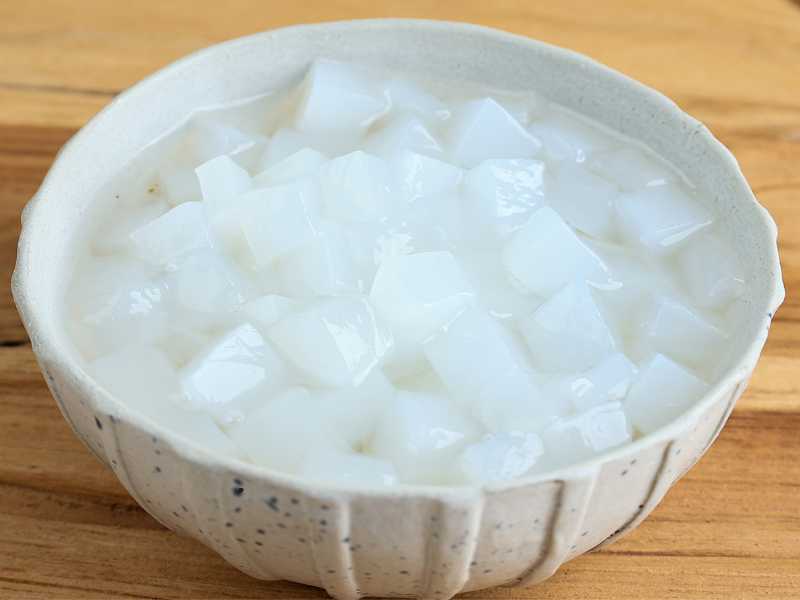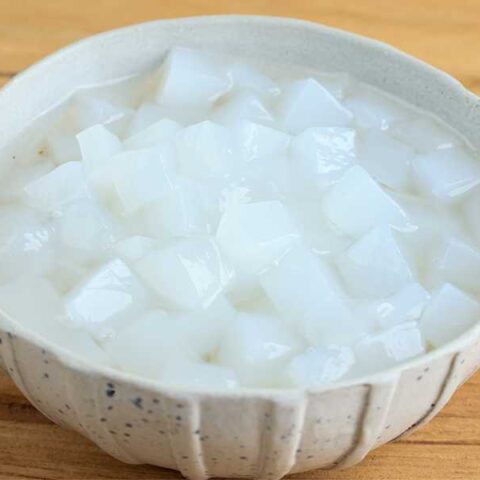Filipino Nata de Coco Recipe

Nata de coco is a sweet jelly made from a mixture of coconut, sugar, water and a culture starter, popular in the Philippines. The mixture is fermented for several days then cut into cubes. The cubes are then used to make beverages, desserts and snacks.
Nata de coco means cream of coconut. It can be made by several different methods. In the Philippines it is widely available but isn’t typically made at home. Some preparations are made using coconut water, coconut pulp or a combination of the two.
No matter the method or ingredients, it requires additional commercially available ingredients like acetobacter xylinum or gluconobacter xylinum, bacteria which helps the mixture to form a jelly.
They are also known as nata starters. The starter turns the sugars into cellulose, creating the texture nata de coco is enjoyed for.
Nata de coco is used in beverages like bubble tea, fruit juices and coconut milk drinks. It is packaged on its own to eat as a snack. Some desserts containing nata de coco is mango bango, a sweetened, creamy mango treat and halo-halo, a Filippino shaved ice desert.
Origin and Cultural Significance
Nata de coco originated in the late 1940’s. The process to create nata de coco was founded by a Filipina chemist names Teódula Kalaw África.
It rivaled nata de pina, made from pineapples which up to that point had been the most popular choice for dessert fruit.

Filipino Nata de Coco Recipe
Filipino Nata de coco is a sweet jelly made from a mixture of coconut, sugar, water and a culture starter. The mixture is fermented for several days then cut into cubes.
Ingredients
- Coconut (fresh, grated) - 2.2 lb
- Glacial acetic acid - 1 ¼ cups
- Sugar - 3 cups
- Coconut water - 2 cups
- Water - 12 liters
- Nata starter - 2 liters
Instructions
- In a bowl, mix the grated coconut with the water.
- Use enough water to fully immerse the coconut.
- Allow the mixture to sit for a few minutes to let the flavors infuse.
- Strain the coconut mixture through a cheesecloth or fine mesh sieve, squeezing out as much liquid as possible.
- Discard the solid coconut pulp and retain the water.
- To the infused water, add glacial acetic acid, refined sugar, coconut water, and nata starter.
- Mix well until the sugar is fully dissolved.
- Pour the mixture into clean and sterile fermenting basins or jars, ensuring a depth of about 2 inches.
- Leave some headspace in the containers to allow room for expansion during fermentation.
- Cover the basins or jars with a clean cloth or lid, but do not seal them tightly. This allows for proper airflow during fermentation.
- Place the containers in a warm and undisturbed location.
- Let the mixture ferment for approximately 12 to 14 days. (During this time, the nata de coco will develop and thicken. It’s important not to move or disturb the containers during fermentation.)
- Once the fermentation period is complete, carefully harvest the nata de coco from the containers.
- Gently wash the nata to remove any residue.
- Cut into cubes.
- To eliminate any remaining acidic taste or smell, soak the nata de coco cubes in several changes of fresh water, over a 2-day period, before using.
Nutrition Information:
Yield: 24 Serving Size: 1Amount Per Serving: Calories: 290Total Fat: 12gSaturated Fat: 11gTrans Fat: 0gUnsaturated Fat: 1gCholesterol: 0mgSodium: 160mgCarbohydrates: 47gFiber: 4gSugar: 41gProtein: 1g
Nutrition is provided and calculated by Nutritionix. It is for general information purposes and is only a rough estimation.






